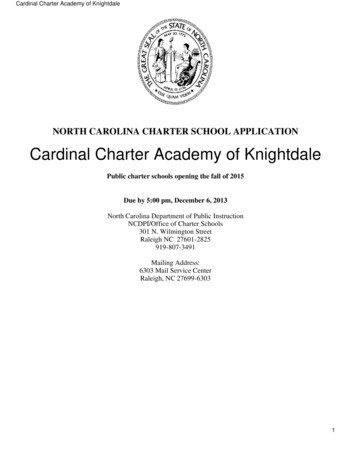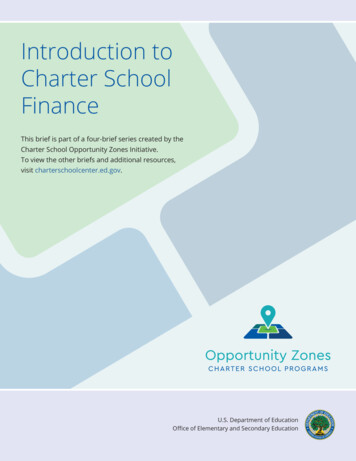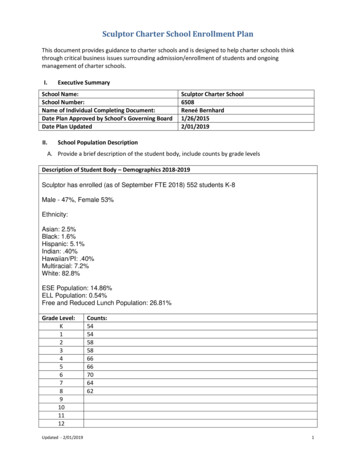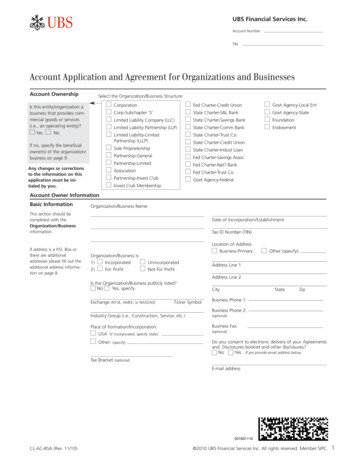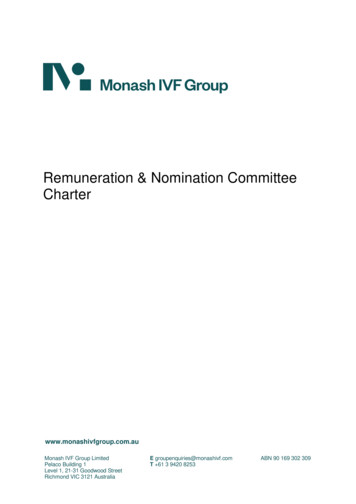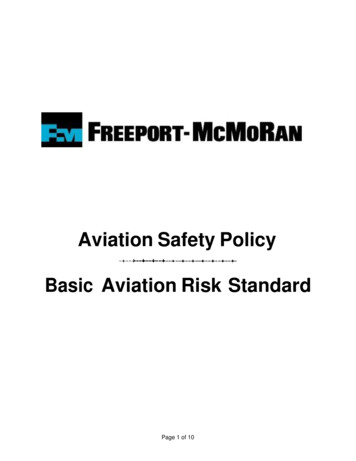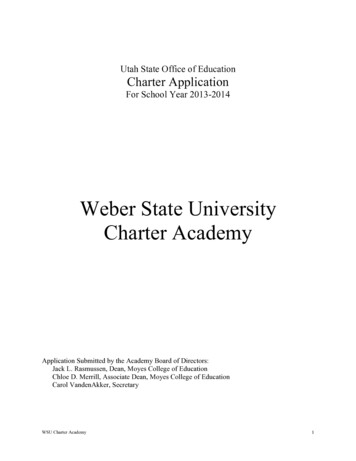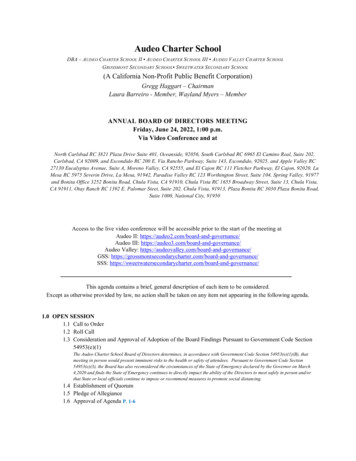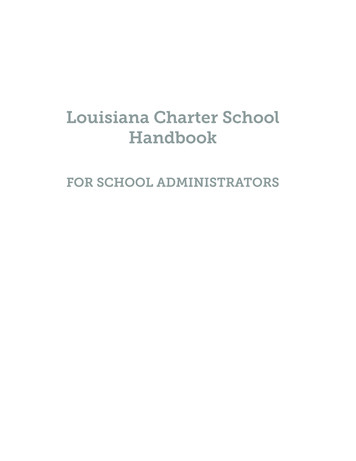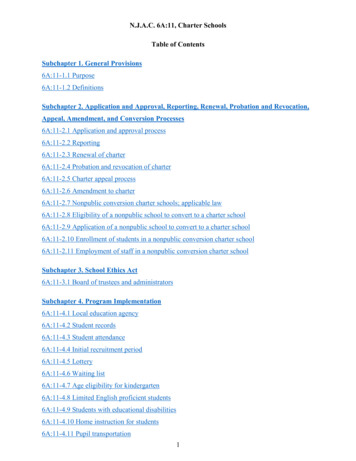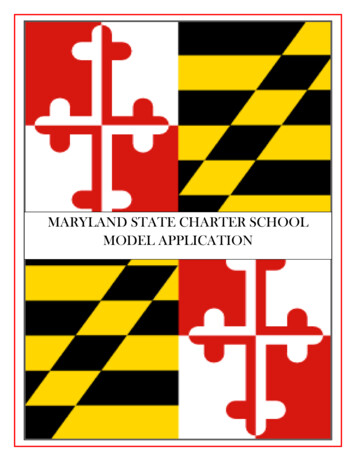
Transcription
MARYLAND STATE CHARTER SCHOOLMODEL APPLICATION
Lillian M. Lowery, Ed. DState Superintendent of SchoolsDr. Charlene M. DukesPresident, Maryland State Board of EducationMartin O’MalleyGovernorHilda L. OrtizState DirectorOffice of School InnovationsMaryland State Department of Education200 West Baltimore StreetBaltimore, Maryland 21201410-767-3677www.MarylandPublicSchools.orgThe Maryland State Department of Education does not discriminate on the basis of age, ancestry, color,creed, gender identity and expression, genetic information, marital status, disability, national origin, race,religion, sex, or sexual orientation in matters affecting employment or in providing access to programs.The contents of the publication were developed under a grant from the U.S. Department of Education.However, the content does not necessarily represent the policy of the Department of Education, and youshould not assume endorsement by the Federal Government.This publication was prepared by Hilda L. Ortiz and Dr. Beverly Mattson, (RMC Research Corporation)consultant to Maryland State Department of Education); with contributions from Monica Taylor, Dr. BrendaKelly, and the Charter School Liaisons representing local school systems in Maryland.Maryland State Department of Education 2012
TABLE OF CONTENTSINTRODUCTION . 1APPLICATION PROCESS, COMPONENTS AND GUIDELINES . 6APPLICATION REQUIREMENTS CHECKLIST . 9LETTER OF INTENT TO APPLY . 12CHARTER SCHOOL APPLICATION COVER SHEET. 13EXECUTIVE SUMMARY . 15A. EDUCATION PLAN . 16Section A.1: Educational School Design .16Section A.2: Curriculum and Instruction .18Section A.3: Assessment System .22Section A.4: School-Specific Goals and Objectives /Comprehensive PerformanceMeasures .24Section A.5: Family Involvement .27Section A.6: Target Population .28Section A.7: Special Student Populations .29Section A.8: School Climate and Discipline.30Section A.9: Student Health and Safety .31Section A.10: School Calendar and Daily Schedule .33Section A.11: Waivers Needed to Implement the Educational Program .34B. ORGANIZATIONAL PLAN . 36Section B.1 School Governance .36Section B.2: Management and Operations .39a. Organizational Structure .39b. Education Service Providers .41c. Student Records .43d. School Policies .43Section B.3: Staffing and Human Resources .46Section B.4: Affiliations and Partnerships.47Section B.5: Student Recruitment and Enrollment .48Section B.6: Waivers Needed to Support the Implementation of the OrganizationalPlan .49C. BUSINESS PLAN . 50Section C.1: Budget .50a. Fundraising Plan.52i
Section C.2:Section C.3:Section C.4:Section C.5:Section C.6:Section C.7:b. Resource Management .52Financial Management .53Facility .54Food Services .56Transportation .57Insurance .58Pre-opening Plan .59EVALUATION CRITERIA . 61Section A - Education PlanSection A.1:Section A.2:Section A.3:Section A.4:Educational School Design .62Curriculum and Instruction .63Assessment System .65School Specific Goals and Objectives/Comprehensive PerformanceMeasures .67Section A.5: Family Involvement .68Section A.6: Target Population .69Section A.7: Special Student Populations .70Section A.8: School Climate and Discipline.72Section A.9: Student Health and Safety .73Section A.10: School Calendar and Daily Schedule .74Section A.11: Waivers Needed to Implement the Educational Program .75Section B-Organizational Plan.76Section B.1.Section B.2.Section B.3Section B.4.Section B.5.Section B.6.School Governance .76Management and Operations .79a. Organizational Structure .79b. Educational Service Providers .81c. Student Records .83d. School Policies .84Staffing and Human Resources .85Affiliations and Partnerships.86Student Recruitment and Enrollment .87Waivers Needed to Support the Implementation of the OrganizationalPlan .88Section C-Business Plan .89Section C.1Section C.2.Section C.3Section C.4.Budget .89a. Fundraising Plan.90b. Resource Management .91Financial Management .92Facility .93Food Services .94ii
Section C.5.Section C.6.Transportation .95Insurance .96OVERALL EVALUATION SUMMARY . 97GLOSSARY. 98CHARTER SCHOOL APPLICATION APPENDICES . 105A.Introduction to Chartering Process .106A.1 Charter School Developers Pathway to Becoming a Charter School .107A.2 Charter School Operators Roles and Responsibilities .109B.Federal Definition of a Public Charter School .111C.Federal Definition of a High Quality Charter School .112D.Maryland Public Charter School Law 2003.114E.Maryland State Board of Education Policy: THE CHARTER SCHOOLPROGRAM .119F.MARYLAND CODE OF REGULATIONS (COMAR): Waivers from Regulations13A.01.01.02-1 .122G.MSDE Facilities Planning Guidelines and Technical Bulletins .125H.Sample List of Facilities Requirements for Charter Schools .127I.Leasing .128J.Construction Plans .130K.Maryland Charter School Quality Standards .132L.Maryland Resources 140M.Charter School Board of Directors - Forms for Section B.1-A . 141N.Other – LEA Specific . 143iii
MARYLAND STATE CHARTER SCHOOL MODEL APPLICATIONINTRODUCTIONIn 2003, the Public Charter School Law was enacted in Maryland to establish the CharterSchool Program. The general purpose of the charter school program, as defined by law, “is tocreate alternative means within the existing public school system in order to provideinnovative learning opportunities and creative educational approaches to improve theeducation of students” (Maryland Public Charter School Act, 2003). Subsequently (2010), theMaryland State Board of Education developed policy for the Charter School Program thatclearly defines the obligations of charter schools and their authorizers.Since the enactment of the Maryland Charter School Law, there has been an annual expansionin the number of charter schools across the State. Charter Schools have brought manyopportunities for innovation, school reform and, most importantly, have provided more schoolchoice for Maryland families.Key Principles of Innovation and AccountabilityHistorically, there are two key principles that guide charter schools. The first is that they areprovided an opportunity to operate autonomously in exchange for school innovation, andsecond, that they are held accountable for student achievement and school performance as acondition of their charter.Innovation in education has been defined as a new approach that brings an improved result.The innovations can be small or large, mostly recognizable, or entirely new and different(Smith, 2009). Pincus (1974) elaborated that innovations in education should be thought of astechnologies that improve educational outcomes, improve working relationships or processeswithin schools, or reduce the costs of education without significantly reducing the quality ofdesired outcomes or processes. Some of the major areas in which charter schools haveimplemented educational innovations are: teaching and learning, school organization,governance and management, and parent and community engagement (Arsen, Plank, & Sykes,1999; Smith & Wohlstetter, 2009).In return for autonomy, charter schools are held accountable for: Meeting or exceeding state and district academic achievement targets Success in meeting the performance goals set in the contract Responsible use of public funds Compliance with all applicable laws and regulations not waived for charter schools.1
MARYLAND STATE CHARTER SCHOOL MODEL APPLICATIONU.S. Department of Education’s Definition of High-quality Charter SchoolThe U.S. Department of Education defines a high-quality charter school as: (1) showingevidence of strong academic results, based on indicators; and (2) has no significant issues inthe areas of student safety, financial management, or statutory or regulatory compliance. Thefull federal definition is included in Appendix B. For more information on the variousprovisions of the federal charter school program authorizing statute (Title V, Part B of theElementary Secondary Education Act (ESEA), refer to the U.S. Department of Education’scharter school program non-regulatory guidance handbook.Maryland Charter School Quality StandardsTo strengthen the quality of charter schools in Maryland, the Office of School Innovations ofthe Maryland State Department of Education (MSDE) identified quality charter schoolindicators, standards, critical success factors (CSF), and performance measures. Indicators area general dimension of school quality or achievement. The identified five indicators address:(A)Culture of continuous improvement;(B)Innovative practices;(C)Student learning and achievement;(D)School and community engagement; and(E)Governance, leadership, and organizational structures.Each indicator includes a standard. The standard is a quality benchmark that is established asa model or an example of a high quality charter school. Connections with the Charter SchoolQuality Standards are made throughout the document and indicated by a [QS and CSF#]. Thebracket will indicate the indicator and the critical success factor that the charter schooldeveloper should refer to in preparation of the application. The summary of the QualityStandards are included in Appendix K.MSDE has prepared accompanying Implementation Guides with a review of the research andliterature, references, and resources for each of the five Indicators. Each implementation guidehas several purposes: (1) describes Maryland’s quality charter school standards for charterschool authorizers, operators, and stakeholders; (2) helps map out charter schoolimprovement, growth, and development; (3) serves as a resource for the charter school stakeholders community on the latest literature and research on charter schools. The ultimate goalis that charter schools in Maryland will take ownership of the standards and use the standardsto define quality for their school.2
MARYLAND STATE CHARTER SCHOOL MODEL APPLICATIONIt is strongly encouraged that potential applicants review the Maryland Charter School QualityStandards Implementation Guides using a reflective process. MSDE has also produced a guidein which team members can review - Facilitation Guide for Discussion of Maryland CharterSchool Quality Standards Implementation Guides for Indicators A through E. The purpose ofthe facilitation guide is to assist discussion groups of charter school stakeholders in reviewingand developing a common understanding of the Maryland Public Charter School QualityIndicators and Standards as described in the Maryland Charter School Quality StandardsImplementation Guides.For further information and resources, access the Maryland State Department of Education,Office of School Innovations web site ms/charter schools/ReferencesArsen, D., Plank, D., & Sykes, G. (1999). The rules matter: School choice policies inMichigan. East Lansing, MI: Michigan State University.Maryland Annotated Code. (2003). Title 9 of the Education Article, Annotated Code ofMaryland, is known as the “Maryland Public Charter School Program”.Maryland State Board of Education (2010). Maryland State Board of Education Policy: TheCharter School Program. Baltimore, MD: Author.Maryland State Department of Education, Office of School Innovations (2012). Marylandcharter school quality standards implementation guides for indicators A through E.Baltimore, MD: Author.Maryland State Department of Education, Office of School Innovations (2011). Facilitationguide for discussion of Maryland charter school quality standards implementationguides for Indicators A through E. Baltimore, MD: AuthorPinkus, J. (1974). Incentives for innovation in the public schools. Review of EducationalResearch, 44 (4), 113-144.Smith, J., & Wohlstetter, P. (2009, October). Parent involvement in urban charter schools: Anew paradigm or the status quo. Prepared for School Choice and SchoolImprovement: Research in State, District and Community Contexts, VanderbiltUniversity. Nashville, TN: National Center on School Choice, Vanderbilt University.U.S. Department of Education (no date). Federal definition of high quality charter schools.Washington, DC: Author.3
MARYLAND STATE CHARTER SCHOOL MODEL APPLICATIONMaryland Charter School Model ApplicationMaryland’s Charter School Model Application provides guidance to Charter SchoolAuthorizers in developing a transparent and concise application process for charter schooldevelopers. This model process was a collaborative effort by the local school systems’ charterschool liaisons representing Maryland authorizers to ensure that a quality process is adoptedby all authorizers.This document is intended to communicate the minimum standard for producing acomprehensive, high quality, and complete charter school application.Authorizers are encouraged to build upon this format as a template and ensure that itcorresponds closely with local charter school policies. For example, individual schooldistricts may choose to weight certain items in the application differently, may have additionalrequirements, or may have adopted an entirely different format. The model applicationprocess aligns closely with the Maryland Charter School Law adopted in 2003 and the StateCharter School Policy of 2010.The application process incorporates three phases: 1) prior to application; 2) the applicationcomponents, and 3) the application review and evaluation. The primary applicationcomponents include: A) Education Plan; B) Organizational Plan, and C) Business Plan. Eachsection includes background information for consideration, and application description. Theapplication requirements checklist on page 9 may be used by both the applicant and theauthorizer to monitor the completeness of the application. The Evaluation Criteria providesthe authorizer with means of determining the quality of the application sections. TheEvaluation Criteria may also be used by the applicant to target the development of a highquality charter school application.Although the format for the standard application is compartmentalized into the differentapplication components, it is important to remember that each of the components relates toone another. The completed application should present a clear picture of what the school willlook like, feel like and what the school will accomplish. The vision and mission should beevident throughout the application and all program elements and resource allocations shouldbe in alignment with the proposed budget and school program. Key to a successfulapplication is that the process provides transparent communication that outlines clearexpectations and provides the guidance to provide a comprehensive package.As a charter school authorizer, the(Insert School System) invites proposals tostart charter schools that are likely to achieve strong educational outcomes. Charter Schoolsare expected to provide families with educational options of many different shapes and sizesbut with one thing in common: quality education.4
MARYLAND STATE CHARTER SCHOOL MODEL APPLICATIONThis application packet will guide you through the steps of developing a charter schoolproposal. Each section requests information about a specific aspect of your plan and presentsthe evaluation criteria that reviewers will use to determine whether the section meets thestandard for approval. Experience has shown that successful charter schools tend to have anumber of common characteristics: A clear, focused, results-oriented mission statement that aligns all parts of theproposal and is furthered by specific, strategic and measurable goals and objectives; Demonstrated understanding of the population that the school is likely to serve; An educational program with research based components that have proven to beeffective for the target population to be served; Strong and diverse leadership and governance; and Strong financial planning and management.Charter schools are secular, tuition-free public schools that operate as independent nonprofitorganizations. They offer new public education options to children, families, teachers andschool leaders. Our state’s charter school legislation offers students, families and educatorsmore choices in public education. It allows charter schools flexibility in how they operate inexchange for establishing higher expectations for educating students well.We look forward to receiving well-developed applications from capable charter schooldevelopers who are committed to educating their students well and improving the lives ofchildren and families in our community. Thank you for your interest in creating a charterschool in Maryland.Please refer to Appendix A for an Introduction to the Chartering Process.If you have any questions regarding this application or the evaluation process, pleasecontact:Insert Authorizer’s name and address5
MARYLAND STATE CHARTER SCHOOL MODEL APPLICATIONApplication Process, Components and GuidelinesPlease read the application carefullyApplication ProcessThe application process consists of the following phases: 1) Prior to the Application; 2) theapplication components, and 3) the application review and evaluation.Phase I:Prior to ApplicationLetter of IntentEach applicant must submit a Letter of Intent identifying pertinent information about the proposedcharter school, including but not limited to the location, projected grades served, enrollment, andidentification of the founding group. The exhibits include a template that may not be altered except toinsert the required information unique to each applicant. By completing the template, the applicantacknowledges and accepts the requirements and expectations therein.Executive Summary as the prospectusPhase II: The Application ComponentsCover SheetThe Cover Sheet provides a summary of key information related to the proposed school,including geographic location, enrollment projections, and applicant contact information.Executive SummaryThe Executive Summary serves as a prospectus to provide the authorizer with basic andkey information regarding your school design. It also serves as an introduction to youroverall charter school application.The Narrative (Sections A through C)The three sections of the Narrative are the Education Plan, Organizational Plan, andBusiness Plan. Within each section, there are specific response categories (e.g.,Curriculum and Instruction under the Education Plan or Budget under the Business Plan).Each response category includes the following: Applicant Instructions that inform you what you are expected to present. Statutory Reference(s) that document the legal authority for the request. (MarylandCharter School law, Title 9. Maryland Charter School Program, Section 9-104). Applicable Maryland Charter School Quality Standards and Critical Success Factors.6
MARYLAND STATE CHARTER SCHOOL MODEL APPLICATIONEvaluation Criteria and Required ExhibitsThis section contains the evaluation criteria by which reviewers will evaluate yourresponse and the required exhibits (if applicable) listing attachments that you are requiredto provide as part of the response.Application Format RequirementsThe Application should adhere to the following format: Hard copy on white, 8.5” x 11” paper One-inch margins on all sides Minimum 11-point font Paragraph formatting may not be more compact than standard single space Spiral-bound (3-ring binders are also acceptable; no paper clips or folders, please)There is no minimum length for an application.There are, however, strict limits on the maximum number of pages: Narrative:maximum of 50 pages, Attachments: maximum of 50 pages. There is ampleopportunity to develop a high quality application within these boundaries.Application Deadline and Submission RequirementsThe application package should include the following One clearly labeled, unbound original copy Six spiral-bound copieso An electronic version of the application (MS Word or compatible format) on eithera CD or USB compatible flash drive (only attachments easily transferable to diskneed to be included electronically)The full Application must be received by our office no later than 4 p.m. on the date of thedeadline. Please mail or hand deliver the application package to:.A copy of the full application should also be submitted to the MSDE’s Office of SchoolInnovations located at 200 W. Baltimore Street, 4th Floor, Baltimore, MD 212017
MARYLAND STATE CHARTER SCHOOL MODEL APPLICATIONPhase III: The Application Review and EvaluationReview for Requirements:The application is reviewed upon receipt to ensure that it meets requirements. If theapplication does not meet requirements, the applicant will be notified that they are notqualified to enter the next stage of this process. Due to the time bound nature of the process,the authorizer will not extend an opportunity for the applicant to address deficiencies at anystage of the process once the application cycle has officially begun. It is therefore importantthat you carefully cross check your application against the guidelines in the document beforeit is delivered to the Authorizer.Application Evaluation:The Full Application will be reviewed by the Authorizer’s Evaluation Committee using theApplication Evaluation Criteria which summarizes the evaluation criteria for each of theapplication sections. Applicants will be notified no later than (number) weeks after submission ifthe Application has been accepted.Capacity Interview:Applicants may be invited along with their founding group and/or proposed board of trusteesto participate in the final phase of the application process. The primary purpose of theinterview is to assess the capacity of the board to effectively oversee the school’s academicprogram, organizational viability, and finances. The interview is designed to determine thefounding group’s understanding of academic and operational accountability as well as thedemographics and other characteristics of the district where the proposed school will belocated. In addition, the interview will provide opportunities to address questions generatedby reviewers during the application review process, provide further verbal clarification, orelaborate on responses within the written application. The Capacity Interviews are scheduled(insert date).Application Notification: Applicants will be notified no later than (number) weeks aftersubmission if the Application has been accepted.Phase IV: Issuing the Charter Letter of Charter Approval
Arsen, D., Plank, D., & Sykes, G. (1999). The rules matter: School choice policies in Michigan. East Lansing, MI: Michigan State University. Maryland Annotated Code. (2003). Title 9 of the Education Article, Annotated Code of Maryland, is known as the "Maryland Public Charter School Program". Maryland State Board of Education (2010).
